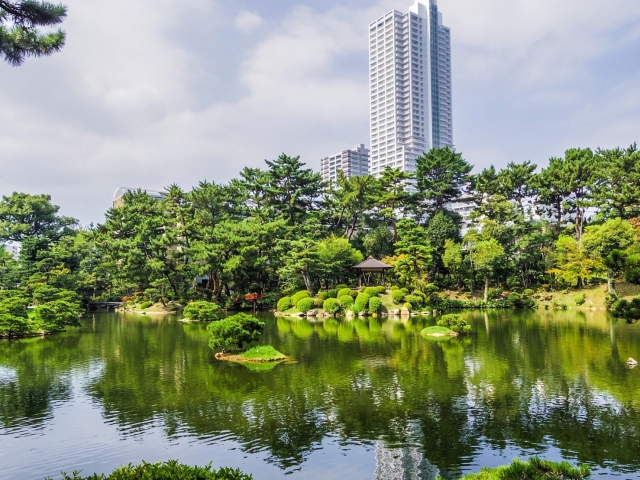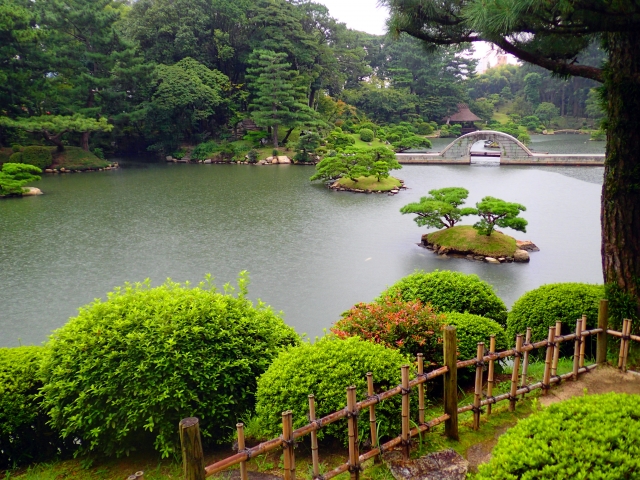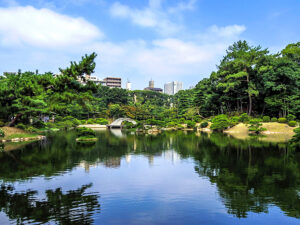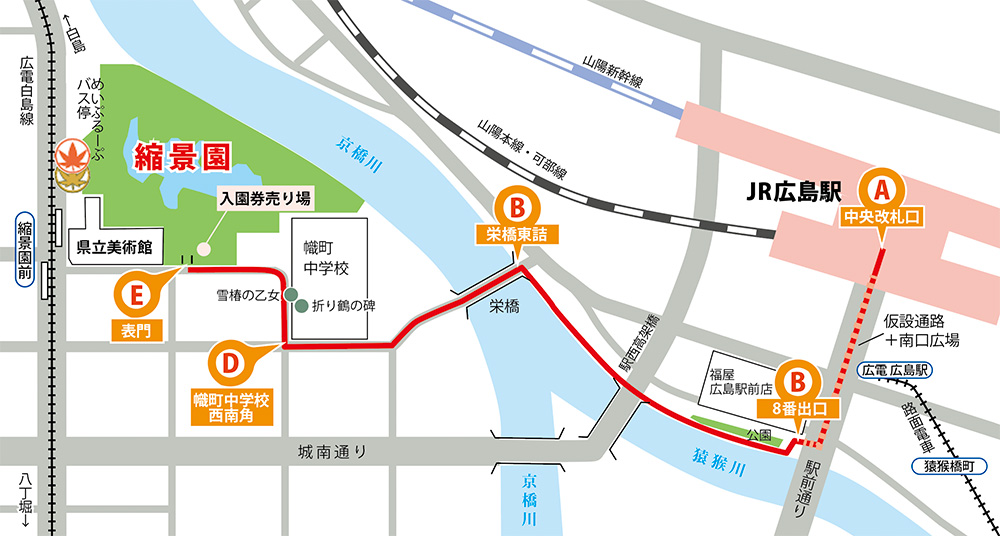One of the sightseeing spots in Hiroshima City is Shukkeien Garden.
But 850m is not a distance that you can walk. Depending on how fast you walk, it takes about 15 or 6 minutes.
I would like to show you the course to Shukkeien on foot while showing you the photos taken at that time.
Of course, you can take the train or bus from Hiroshima Station to Shukkeien, but considering the waiting time and transfers, walking is faster and healthier, and I would like to recommend it. (^_^)
You can take several routes, but I took the route shown in the red line in the figure this time. The route passes by the river, so the scenery is nice, and you can also see a monument to pray for peace at the Noboricho Junior High School.
As I mentioned below, the time in parentheses is the actual time I measured on foot. I tried to walk in an average way, but it may vary from person to person. Please understand that.
Hiroshima Station ticket gate → South exit underground plaza → Exit 8 (4 minutes) Total 16 min.
Please also refer to Google Map.
Below is the explanation of each point. You can also return to the map at the beginning of the tour by clicking the “Return to Course Map” button along the way, so please use it accordingly.
1 From the central ticket gate of Hiroshima Station, go through the underground plaza to Exit 8 (4 minutes)
The starting point is the central ticket gate of Hiroshima Station [A in the figure] .
After exiting the Central Gate, you will see the North-South Free Passage, and go to the right (South). You will see a big sign that says “South Exit.
Go down the escalator (and stairs) to the first floor.
Follow the street for a while and you will come to a point where the streetcar and bus lines 6-9 and bus lines 1-5 divide, so take the streetcar and bus lines 6-9 (left).
Do not go to “Mazda Stadium” or “Taxi” in front of it.
Take the South Exit. There is an entrance to an underground passageway in front of the South Exit.
Go straight ahead and you will see the South Exit Underground Plaza and Yale A Building. Follow the signs and go straight to “Exit 8.
At the end of the street is “Exit 8. Go up here to the ground level.
It took 4 minutes from the central ticket gate of JR Hiroshima Station to this point.
2 From Exit No. 8, walk along the edge of the river to the east end of Sakae-bashi Bridge (5 minutes)
This is the exit from the previous exit. There is a bus stop and on the right you can see the Fukuya Hiroshima Ekimae Store (Yale A building).
From here, walk along the Enko River (Kyobashi River upstream). I love this view of buildings and the river, which is very Hiroshima-like. It is a pleasant area with greenery.
Continue walking straight along the river for a while.
On the way, you will see a small torii gate with the name “Shoichi Matsubara Inari Daijin” written on it. There is also a stone monument with the inscription “Matsubara Senbonzakura (Thousand Cherry Trees in Matsubara)” near the torii. It seems to have been erected to celebrate the opening of the Sanyo Shinkansen in 1975.
In the front is the Station West Viaduct.
You can also turn left along the viaduct, but this time we will go straight and cross at Sakae-bashi Bridge.
Sakae Bridge can be seen in front of you.
You have arrived at the east end of Sakae-bashi Bridge (C in the figure). It took 5 minutes from Exit 8 to this point.
3 Cross Sakae Bridge to Noboricho Junior High School (“Maiden of Snow Camellia” and “Monument of Origami Cranes”) (4.5 minutes)
Cross Sakae Bridge.
Follow the road a little further and you will come to a traffic light. Cross the pedestrian crossing to the right side of the road and go straight ahead in the direction in front of you. Continue along the road and you will be behind the Hiroshima Municipal Noboricho Junior High School .
This is Noboricho Junior High School. Is this the back gate? Is this the back gate?
Sadako Sasaki, the model for the Children of the Atomic Bomb statue in Peace Memorial Park, was a student at Noboricho Junior High School.
[D] on the map .
A little further on, you will see the “Maiden of Snow Camellia” and the “Monument of Origami Cranes,” and beyond them is the main gate. (The Maiden of Snow Camellia is on the sidewalk, and the Monument of Origami Cranes is inside the school.)
Maiden of Snow Camellia Monument of Folded Cranes
Maiden of Snow Camellia”
The “Monument of Origami Cranes”
4From “Maiden of Snow Camellia” to the entrance of Shukkeien Garden (2.5 minutes)
Turn left along the road in front of Noboricho Junior High School.
After a short distance, you will see the east gate (service entrance) of Shukkeien on your right.
Back gate of Shukkeien (service entrance) From this area, you will see a green sign “Meisho Shukkeien” on the left side of the road. This is the parking lot of Shukkeien, and the entrance to the main gate is across the street (on the right).
If you are coming by car or rental car, it is convenient to park here.
This is the main gate of Shukkeien Garden,.
At the time of the interview, several foreign visitors were entering the park. I was a little happy that foreign visitors could feel that the Peace Memorial Park and Miyajima are not the only places to visit.
Entrance Fees and Opening Hours of Shukkeien Garden,
Here is a summary of admission fees, opening hours, and the official website of Shukkeien Garden,.
Entrance Fees General: 260 yen, High school and university students: 150 yen, Elementary and junior high school students: 100 yen Fee for the combination of Shukkei-en Garden and the Prefectural Museum of Art General admission: 610 yen, college students: 350 yen (no other fees) Opening hours March 16-September 15 (9:00-18:00) Home page http://shukkeien.jp/ Address/Tel 2-11 Kaminobori-machi, Naka-ku, Hiroshima City 082-221-3620
For those who wish to enjoy both the Hiroshima Prefectural Art Museum and Shukkeien Garden, a set price is available (see table above). The admission fee for the Prefectural Art Museum is 510 yen for adults and 310 yen for university students, so you can save 160 yen for adults and 110 yen for university students compared to paying separately.
Extra 1] Enjoy the adjacent Hiroshima Prefectural Art Museum
This is off the theme of this article, but I would like to write a little about the Hiroshima Prefectural Art Museum , which is located next to Shukkeien.
The Hiroshima Prefectural Art Museum is one of the major art museums in Hiroshima City, along with the Hiroshima Museum of Art in Chuo Park and the Hiroshima MOCA Museum of Contemporary Art in Hijiyama Park, Minami Ward.
The museum holds special exhibitions, exhibitions of works in its collection, exhibitions of works by prefectural residents, and special exhibitions in cooperation with Shukkei-en Garden. At the time of our visit, a Dali exhibition was being held as a special exhibition.
If you have time, this is also a must-see spot.
How to get to Hiroshima Prefectural Art Museum
After leaving Shukkeien, turn right (west) on the street and you will soon come to the museum building. Walk along the side of the building.
If you come from the direction of Shukkeien, the entrance is on the side of the museum, not in front of it, but the entrance is on the right in the picture, so you should enter the museum as shown by the arrow.
By the way, the front (as seen from the streetcar) looks like this.
Admission and Opening Hours of Hiroshima Prefectural Museum of Art
The following is a summary of the admission fees, opening hours, and official website of the Hiroshima Prefectural Art Museum.
Museum Admission Fees Adults: 510 yen, University students: 310 yen, High school students, children under 18 years old, and those over 65 years old: free High school students, persons under 18, and persons over 65: Free of charge . . Admission to the exhibition of artworks in the collection is also free with a ticket for the special exhibition. Fee for the combination of Shukkeien Garden and the Prefectural Museum of Art Adults: 610 yen, college students: 350 yen (no other fees) Hours of operation 9:00 – 17:00 (Admission until 16:30) Open until 19:00 on Fridays until March 31, 2023 ・ Open until 20:00 on Fridays from April 1 to September 24, 2023 ・ Open until 19:00 on Fridays from September 25 to March 31 Closed Mondays , year-end and New Year holidays, and exhibition change periods ・The museum is open on Mondays when Monday is a national holiday, substitute holiday, or when some special exhibitions are being held. ・The museum is closed during the year-end and New Year holidays (December 25 – January 1) ・ Some special exhibitions are closed during the exhibition period, national holidays, and substitute holidays. Home page https://www.hpam.jp/museum/ Address/Tel 2-22 Kaminobori-machi, Naka-ku, Hiroshima City 082-221-624
Extra 2] I walked further to Hiroshima Castle!
On the day of the interview, I walked further to Hiroshima Castle, so I will write a little about that.
Hiroshima Castle is almost straight west when seen from Shukkeien. It is about 600 meters from the entrance of Shukkeien to the back gate of the castle, and it took about 9 minutes to walk there. (It takes about another 200m/3 minutes to get to the castle tower.)
Directions from Shukkeien to Hiroshima Castle
After leaving Shukkeien, turn right, pass the Prefectural Museum of Art, and get on Densha-dori (streetcar). Cross the street at the “Shukkeien-mae” streetcar stop.
Hiroshima Electric Railway “Shukkeien-mae” streetcar stop
Intersection in front of the Prefectural Museum of Art Continue straight down the street. The East Taxation Office and Summary Court will be on your right, and the Joint Government Office Building will be on your left.
Hiroshima Higashi Tax Office on the right. Hiroshima Summary Court. District Court is in the back. At the end of the street is a T-junction. If you go a little to the right here, you will see a large torii gate of Hiroshima Gokoku Shrine on your left.
After passing through the large torii gate and crossing the moat, you will come to the Ura-gomon (ruins). To get to the castle tower, walk straight for about 3 minutes, but you will find it easily.
Admission and Opening Hours of Hiroshima Castle
Here is a summary of the admission fees, opening hours, and official website for Hiroshima Castle.
Admission Fees [ Adults 370 yen, Seniors (65 and over) and high school students 180 yen, Junior high school students and younger free Seniors must have proof of age when purchasing tickets. Admission is free. Hours of Operation [ Tenshukaku] March – November: 9:00 – 18:00*entry until 17:30 *entry until 16:30 [Ninomaru] April – September: 9:00 – 17:30*entry until 17:00 *entry until 16:00 Closed [ Tenshukaku] Year-end and New Year holidays (Dec. 29-31) *Special holidays apply. Ninomaru] Year-end and New Year holidays (December 29 – January 2) Home page https://www.rijo-castle.jp/ Address/Tel 21-1 Motomachi, Naka-ku, Hiroshima City 082-221-7512
Summary
We have introduced how to get from JR Hiroshima Station to Shukkeien Garden and then to Hiroshima Castle on foot.
In a separate article, we wrote about how to get to Shukkeien by train, bus, or cab. I think you should decide according to the number of people, the weather, and your mood.
It is a healing space close to both Hiroshima Station and Hacchobori. Please come and visit us!
You'd also like to read
Summary of how to get to Shukkeien Garden from Hiroshima Station! By train, bus, car, or on foot
Shukkeien Garden is a green and healing place in the center of Hiroshima City. It is one of the city’s most popular tourist spots, along with Peace Memorial Park and other places. The following is a summary of the attractions of Shukkeien and how to access it.





Comments